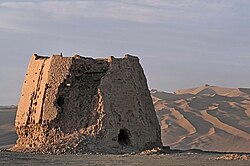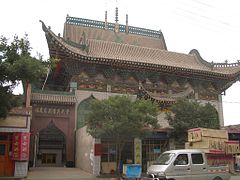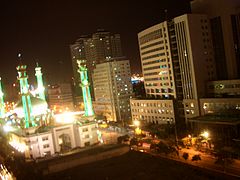Gansu is a province in Northwest China. Its capital and largest city is Lanzhou, in the southeast part of the province.
The seventh-largest administrative district by area at 453,700 square kilometres (175,200 sq mi), Gansu lies between the Tibetan and Loess plateaus and borders Mongolia (Govi-Altai Province), Inner Mongolia and Ningxia to the north, Xinjiang and Qinghai to the west, Sichuan to the south and Shaanxi to the east. The Yellow River passes through the southern part of the province. Part of Gansu’s territory is located in the Gobi Desert. The Qilian mountains are located in the south of the Province.
Gansu has a population of 26 million, ranking 22nd in China. Its population is mostly Han, along with Hui, Dongxiang and Tibetan minorities. The most common language is Mandarin. Gansu is among the poorest administrative divisions in China, ranking 31st, last place, in GDP per capita as of 2019.
The State of Qin originated in what is now southeastern Gansu and went on to form the first known Empire in what is now China. The Northern Silk Road ran through the Hexi Corridor, which passes through Gansu, resulting in it being an important strategic outpost and communications link for the Chinese empire.
The city of Jiayuguan, the second most populated city in Gansu, is known for its section of the Great Wall and the Jiayuguan Pass fortress complex.

Name
Gansu is a compound of the names of Gānzhou (now the main urban district and seat of Zhangye) and Sùzhou (an old name and the modern seat of Jiuquan), formerly the two most important Chinese settlements in the Hexi Corridor.
Gansu is abbreviated as “甘” (Gān) or “陇” (Lǒng), and was also known as Longxi (陇西; ‘”[land] west of Long”‘) or Longyou (陇右; ‘”[land] right of Long”‘) prior to early Western Han dynasty, in reference to the Long Mountain (the modern day Liupan Mountain‘s southern section) between eastern Gansu and western Shaanxi

History
Gansu’s name is a compound name first used during the Song dynasty. It is a combination of the names of two prefecture (州) in the Sui and Tang dynasty: Gan (around Zhangye) and Su (around Jiuquan). Its eastern part forms part of one of the cradles of ancient Chinese civilisation.
Ancient Gansu
In prehistoric times, Gansu was host to Neolithic cultures. The Dadiwan culture, from where archaeologically significant artifacts have been excavated, flourished in the eastern end of Gansu from about 6000 BC to about 3000 BC. The Majiayao culture and part of the Qijia culture took root in Gansu from 3100 BC to 2700 BC and 2400 BC to 1900 BC respectively.
The Yuezhi originally lived in the very western part of Gansu until they were forced to emigrate by the Xiongnu around 177 BCE.
The State of Qin, known in China as the founding state of the Chinese empire, grew out from the southeastern part of Gansu, specifically the Tianshui area. The Qin name is believed to have originated, in part, from the area.Qin tombs and artifacts have been excavated from Fangmatan near Tianshui, including one 2200-year-old map of Guixian County.
Imperial era
In imperial times, Gansu was an important strategic outpost and communications link for the Chinese empire, as the Hexi Corridor runs along the “neck” of the province. The Han dynasty extended the Great Wall across this corridor, building the strategic Yumenguan (Jade Gate Pass, near Dunhuang) and Yangguan fort towns along it. Remains of the wall and the towns can be found there. The Ming dynasty built the Jiayuguan outpost in Gansu. To the west of Yumenguan and the Qilian Mountains, at the northwestern end of the province, the Yuezhi, Wusun, and other nomadic tribes dwelt (Shiji 123), occasionally figuring in regional imperial Chinese geopolitics.
By the Qingshui treaty, concluded in 823 between the Tibetan Empire and the Tang dynasty, China lost much of western Gansu province for a significant period.
After the fall of the Uyghur Khaganate, a Buddhist Yugur (Uyghur) state called the Ganzhou Uyghur Kingdom was established by migrating Uyghurs from the Khaganate in part of Gansu that lasted from 848 to 1036 AD.
Along the Silk Road, Gansu was an economically important province, as well as a cultural transmission path. Temples and Buddhist grottoes such as those at Mogao Caves (‘Caves of the Thousand Buddhas’) and Maijishan Caves contain artistically and historically revealing murals. An early form of paper inscribed with Chinese characters and dating to about 8 BC was discovered at the site of a Western Han garrison near the Yumen pass in August 2006.
The Xixia or Western Xia dynasty controlled much of Gansu as well as Ningxia.
The province was also the origin of the Dungan Revolt of 1862–77. Among the Qing forces were Muslim generals, including Ma Zhan’ao and Ma Anliang, who helped the Qing crush the rebel Muslims. The revolt had spread into Gansu from neighbouring Qinghai.
There was another Dungan revolt from 1895 to 1896.
Republican China
As a result of frequent earthquakes, droughts and famines, the economic progress of Gansu was significantly slower than that of other provinces of China until recently. Based on the area’s abundant mineral resources it has begun developing into a vital industrial center. An earthquake in Gansu at 8.6 on the Richter scale killed around 180,000 people mostly in the present-day area of Ningxia in 1920, and another with a magnitude of 7.6 killed 275 in 1932.
The Muslim Conflict in Gansu (1927–1930) was a conflict against the Guominjun.
While the Muslim General Ma Hongbin was acting chairman of the province, Muslim General Ma Buqing was in virtual control of Gansu in 1940. Liangzhou District in Wuwei was previously his headquarters in Gansu, where he controlled 15 million Muslims. Xinjiang came under Kuomintang (Nationalist) control after their soldiers entered via Gansu. Gansu’s Tienshui was the site of a Japanese-Chinese warplane fight.
Gansu was vulnerable to Soviet penetration via Xinjiang. Gansu was a passageway for Soviet war supplies for the Republic of China during the Second Sino-Japanese War. Lanzhou was a destination point via a road coming from Dihua (Ürümqi). The Gonxingdun Aerodrome was one of several air bases where the Chinese Air Force operated in defense of Gansu. Gansu provided wartime China with most of the locally sourced petrol from the Yumen Laojunmiao oil wells beginning in the summer of 1939, producing 250,000 tons of crude oil in those war years. Lanzhou and Lhasa were designated to be recipients of a new railway.
The Kuomintang Islamic insurgency in China (1950–1958) was a prolongation of the Chinese Civil War in several provinces including Gansu.
Agriculture
Due to poor natural conditions such as aridness, Gansu is one of the Chinese provinces with smallest per capita area of arable land. Agricultural production includes cotton, linseed oil, maize, melons (such as the honeydew melon, known locally as the Bailan melon, millet, and wheat.[citation needed] Gansu is known as a source for wild medicinal herbs which are used in Chinese medicine. However, pollution by heavy metals, such as cadmium in irrigation water, has resulted in the poisoning of many acres of agricultural land. The extent and nature of the heavy metal pollution is considered a state secret.
Industry
The industrial sector in Gansu was developed after completion of the Longhai railway in 1953 and blueprinted in the first five-year plan of China. Until 2014, the industrial sector contributed the most to Gansu’s economy. The most important industries are petrochemicals, non-ferrous metallurgy, machinery and electronics. The province is also an important base for wind and solar power. As a result of environmental protection policies, the industry sector is not growing. The manufacturing sector has been shrinking for several years and has low investment numbers.
According to some sources, the province is also a center of China’s nuclear industry.
As stipulated in the country’s 12th Five Year Plan, the local government of Gansu hopes to grow the province’s GDP by 10% annually by focusing investments on five pillar industries: renewable energy, coal, chemicals, nonferrous metals, pharmaceuticals and services.
Culture
A unique variety of Chinese folk music popularly identified with the local peoples of Gansu include the “Hua’er” (flowery melodies), and is popular among the Han and nine ethnic groups of Gansu.The cuisine of Gansu is based on the staple crops grown there: wheat, barley, millet, beans, and sweet potatoes. Within China, Gansu is known for its lamian (pulled noodles), and Muslim restaurants which feature authentic Gansu cuisine.
Religion
According to a 2012 survey around 12% of the population of Gansu belongs to organised religions, the largest groups being Buddhists with 8.2%, followed by Muslims with 3.4%, Protestants with 0.4% and Catholic with 0.1% (in total, as of 2012 Christians comprise 0.5% of the population, decreasing from 1.02% in 2004) Around 88% of the population may be either irreligious or involved in Chinese folk religion, Buddhism, Confucianism, Taoism, and folk religious sects.
Muslim restaurants are common, and feature typical Chinese dishes, but without any pork products, and instead an emphasis on lamb and mutton. Gansu has many works of Buddhist art, including the Maijishan Grottoes. Dunhuang was a major centre of Buddhism in the Middle Ages.
|
https://www.tiktok.com/@lovegansu/video/6957931557868883202











